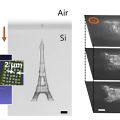Analyse vectorielle - Définition
La liste des auteurs de cet article est disponible ici.
Expressions des opérateurs en différentes coordonnées
Coordonnées cylindriques
Coordonnées sphériques
Quelques formules différentielles
Attention : les formules suivantes sont valables à condition que certaines hypothèses soient vérifiées ! (la fonction scalaire dans la première formule doit être





-

-

Formules dites de Leibniz pour les produits
-


-

-


- (où

-

Quelques formules utiles
- Soient f(M) et g(M) deux champs scalaires,il existe un champ de vecteurs


- Le champ central

son application linéaire tangente est la matrice identité (cf. la définition !),
donc




- D'autre part



-


en particulier


-

- Le champ newtonien, soit

car c'est le seul champ central à divergence nulle (évident si l'on pense en termes de flux)sauf pour r = 0, où elle vaut

Il en résulte que

- Donc

(où

qui se décompose en :




ce qui est moins évident (cf. moment magnétique).
- En mécanique des fluides, il faut retenir encore quelques "évidences" supplémentaires, pour bien se familiariser avec l'analyse vectorielle avant de l'aborder.
- Les formules précédentes sont dites de calcul différentiel. Il convient de les associer aux formules de calcul intégral : formule de Stokes, théorème d'Ostrogradski, etc.
- Enfin, il convient de ne pas perdre de vue le caractère axial ou polaire des champ de vecteurs étudiés. Ce ne sont absolument pas les mêmes entités mathématiques !


































































